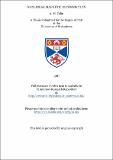Nonlinear magnetic reconnection
Abstract
In many astrophysical problems magnetic reconnection plays a major role. Despite this reconnection theory remains incompletely understood, partly due to the strong non-linearity of the governing equations and the resulting difficulties in demonstrating analytical solutions. This thesis examines some fundamental aspects of reconnection theory: namely, the dynamics of driven and spontaneously reconnecting systems. We first consider the dynamics of a driven reconnecting system by numerically modelling a configuration consisting of two oppositely oriented flux systems with a variety of different boundary conditions and internal parameters. The results indicate that the rate of reconnection is chiefly dependent on the magnetic Reynolds number, but that the plasma flow is weakly dependent on this parameter, being more affected by the curvature of Incoming magnetic field. Scaling laws for the dimensions of the diffusion region are derived, and the existence of several reconnection regimes is shown. Using the same computer code we also simulate tearing modes in Cartesian geometry under different boundary conditions. By imposing a suitable perturbation a magnetic island is generated. The plasma flows show marked differences for the different boundary conditions implemented. Lastly, we examine some aspects of the coalescence instability. The usual flux function taken to represent a tearing node Island in the linear growth phase is shown to be erroneous, and we derive a correct expression. We show that under certain conditions there exists a threshold to coalescence that depends on the island wavenumbers and the associated perturbation.
Type
Thesis, PhD Doctor of Philosophy
Collections
Items in the St Andrews Research Repository are protected by copyright, with all rights reserved, unless otherwise indicated.

